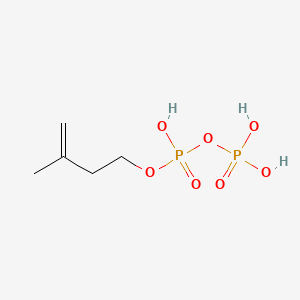| MeSH term | MeSH ID | Detail |
|---|---|---|
| Melanoma | D008545 | 69 associated lipids |
Isopentenyl pyrophosphate
Isopentenyl pyrophosphate is a lipid of Prenol Lipids (PR) class. Isopentenyl pyrophosphate is associated with abnormalities such as Tuberculosis, NAVAJO NEUROHEPATOPATHY and Cryptosporidiosis. The involved functions are known as Signal, Anabolism, T-Cell Activation, T-Cell Proliferation and isoprenoid biosynthetic process. Isopentenyl pyrophosphate often locates in Protoplasm, Host Cell, soluble, Plastids and Cell surface. The associated genes with Isopentenyl pyrophosphate are oxytocin, 1-desamino-(O-Et-Tyr)(2)-, HLA-E gene, RAP1A gene, Gene Family and Orthologous Gene. The related lipids are Steroids, Sterols and isopentenol.
Cross Reference
Introduction
To understand associated biological information of Isopentenyl pyrophosphate, we collected biological information of abnormalities, associated pathways, cellular/molecular locations, biological functions, related genes/proteins, lipids and common seen animal/experimental models with organized paragraphs from literatures.
What diseases are associated with Isopentenyl pyrophosphate?
Isopentenyl pyrophosphate is suspected in Tuberculosis, NAVAJO NEUROHEPATOPATHY, Cryptosporidiosis and other diseases in descending order of the highest number of associated sentences.
Related references are mostly published in these journals:
| Disease | Cross reference | Weighted score | Related literature |
|---|
Possible diseases from mapped MeSH terms on references
We collected disease MeSH terms mapped to the references associated with Isopentenyl pyrophosphate
PubChem Associated disorders and diseases
What pathways are associated with Isopentenyl pyrophosphate
Lipid pathways are not clear in current pathway databases. We organized associated pathways with Isopentenyl pyrophosphate through full-text articles, including metabolic pathways or pathways of biological mechanisms.
Related references are published most in these journals:
| Pathway name | Related literatures |
|---|
PubChem Biomolecular Interactions and Pathways
Link to PubChem Biomolecular Interactions and PathwaysWhat cellular locations are associated with Isopentenyl pyrophosphate?
Visualization in cellular structure
Associated locations are in red color. Not associated locations are in black.
Related references are published most in these journals:
| Location | Cross reference | Weighted score | Related literatures |
|---|
What functions are associated with Isopentenyl pyrophosphate?
Related references are published most in these journals:
| Function | Cross reference | Weighted score | Related literatures |
|---|
What lipids are associated with Isopentenyl pyrophosphate?
Related references are published most in these journals:
| Lipid concept | Cross reference | Weighted score | Related literatures |
|---|
What genes are associated with Isopentenyl pyrophosphate?
Related references are published most in these journals:
| Gene | Cross reference | Weighted score | Related literatures |
|---|
What common seen animal models are associated with Isopentenyl pyrophosphate?
There are no associated biomedical information in the current reference collection.
NCBI Entrez Crosslinks
All references with Isopentenyl pyrophosphate
Download all related citations| Authors | Title | Published | Journal | PubMed Link |
|---|---|---|---|---|
| Zheng Q et al. | Diverse arrangement of photosynthetic gene clusters in aerobic anoxygenic phototrophic bacteria. | 2011 | PLoS ONE | pmid:21949847 |
| Kondo M et al. | Expansion of human peripheral blood γδ T cells using zoledronate. | 2011 | J Vis Exp | pmid:21931292 |
| Haussig JM et al. | Inactivation of a Plasmodium apicoplast protein attenuates formation of liver merozoites. | 2011 | Mol. Microbiol. | pmid:21848587 |
| Chang CW et al. | Identification and categorization of liver toxicity markers induced by a related pair of drugs. | 2011 | Int J Mol Sci | pmid:21845099 |
| Holderness J et al. | Polysaccharides isolated from Açaà fruit induce innate immune responses. | 2011 | PLoS ONE | pmid:21386979 |
| Begley DW et al. | Leveraging structure determination with fragment screening for infectious disease drug targets: MECP synthase from Burkholderia pseudomallei. | 2011 | J. Struct. Funct. Genomics | pmid:21359640 |
| Atsbaha Zebelo S et al. | Chrysolina herbacea modulates terpenoid biosynthesis of Mentha aquatica L. | 2011 | PLoS ONE | pmid:21408066 |
| Odom AR | Five questions about non-mevalonate isoprenoid biosynthesis. | 2011 | PLoS Pathog. | pmid:22216001 |
| Rauthan M and Pilon M | The mevalonate pathway in C. elegans. | 2011 | Lipids Health Dis | pmid:22204706 |
| Nes WD | Biosynthesis of cholesterol and other sterols. | 2011 | Chem. Rev. | pmid:21902244 |
| Bergman P et al. | Studies on the antibacterial effects of statins--in vitro and in vivo. | 2011 | PLoS ONE | pmid:21912631 |
| Olofsson L et al. | Relative expression of genes of terpene metabolism in different tissues of Artemisia annua L. | 2011 | BMC Plant Biol. | pmid:21388533 |
| Zhong YJ et al. | Functional characterization of various algal carotenoid ketolases reveals that ketolating zeaxanthin efficiently is essential for high production of astaxanthin in transgenic Arabidopsis. | 2011 | J. Exp. Bot. | pmid:21398427 |
| Battilana J et al. | Functional effect of grapevine 1-deoxy-D-xylulose 5-phosphate synthase substitution K284N on Muscat flavour formation. | 2011 | J. Exp. Bot. | pmid:21868399 |
| Zeng Y et al. | A proteomic analysis of the chromoplasts isolated from sweet orange fruits [Citrus sinensis (L.) Osbeck]. | 2011 | J. Exp. Bot. | pmid:21841170 |
| Nair SC and Striepen B | What do human parasites do with a chloroplast anyway? | 2011 | PLoS Biol. | pmid:21912515 |
| Cantagrel V and Lefeber DJ | From glycosylation disorders to dolichol biosynthesis defects: a new class of metabolic diseases. | 2011 | J. Inherit. Metab. Dis. | pmid:21384228 |
| Yeh E and DeRisi JL | Chemical rescue of malaria parasites lacking an apicoplast defines organelle function in blood-stage Plasmodium falciparum. | 2011 | PLoS Biol. | pmid:21912516 |
| Vivas Y et al. | Early peroxisome proliferator-activated receptor gamma regulated genes involved in expansion of pancreatic beta cell mass. | 2011 | BMC Med Genomics | pmid:22208362 |
| Zhou K et al. | Novel reference genes for quantifying transcriptional responses of Escherichia coli to protein overexpression by quantitative PCR. | 2011 | BMC Mol. Biol. | pmid:21513543 |
